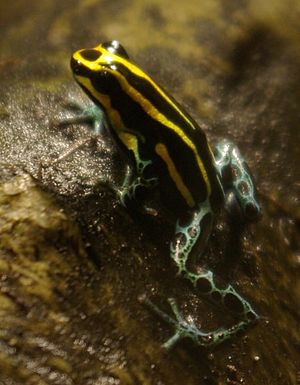Reticulated poison frog facts for kids
Quick facts for kids Reticulated poison frog |
|
|---|---|
 |
|
| Conservation status | |
| Scientific classification | |
| Synonyms | |
|
Dendrobates minutus ventrimaculatus Shreve, 1935 |
The reticulated poison frog (Ranitomeya ventrimaculata) is a small, colorful frog. It lives in the warm, wet rainforests of South America. You can find it in countries like Brazil, Colombia, Ecuador, French Guiana, and Peru. In French, it's called dendrobate à ventre tacheté, which means "spotted belly dart frog."
Its Special Defense
The reticulated poison frog has a special way to protect itself. Its skin makes a mild poison. This poison helps keep away tiny things like fungi and bacteria. It also warns bigger animals, like predators, to stay away. The frog's bright colors are a signal that it's not good to eat.
Even though it's called a "poison frog," its poison is not as strong as some other poison dart frogs. This frog gets its poison from eating a type of tiny bug called a mite.
What It Looks Like
This frog is active during the day. It grows to be about 20 millimetres (0.79 in) long, which is less than an inch. Male frogs are usually a bit smaller than females.
The frog's main color is black. It has bright yellow lines or dots on its back. Its belly is bluish or grayish with black spots. This spotted belly is how it got its name, "ventrimaculatus," which means "spotted belly." The spotted pattern continues down its legs.
Life Cycle
Reticulated poison frogs become adults when they are about six months old. The female frog lays four to eight eggs on leaves, usually just under the water. The male frog then fertilizes the eggs.
After 12 to 16 days, the tiny tadpoles hatch from the eggs. The male frog is a very caring parent! He carries each tadpole, one by one, to small puddles or tiny pools of water. He separates them because tadpoles can sometimes eat each other.
The tadpoles grow and change into frogs over 60 to 80 days. This process is called metamorphosis. Once they are fully formed frogs, they can live on their own. However, they often stay close to where they were born.
Where It Lives
The reticulated poison frog lives in tropical rainforests. You can find them in trees and sometimes on the ground. Sadly, their homes are shrinking because of habitat loss. This means that the rainforests where they live are being cut down or changed, which makes it harder for these frogs to survive.
See also
 In Spanish: Ranitomeya ventrimaculata para niños
In Spanish: Ranitomeya ventrimaculata para niños


